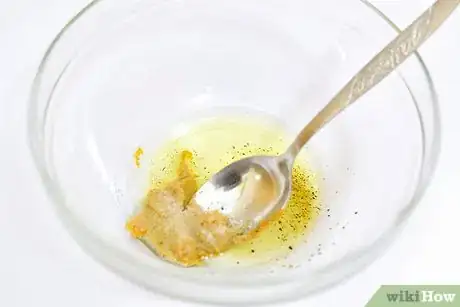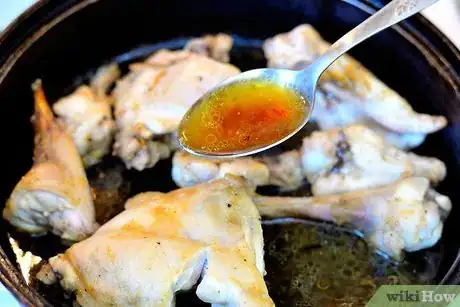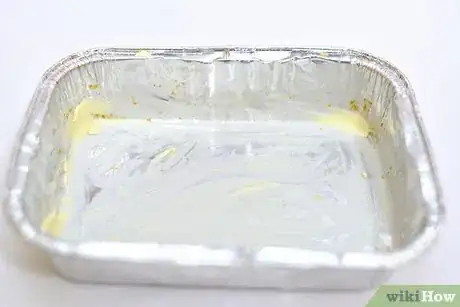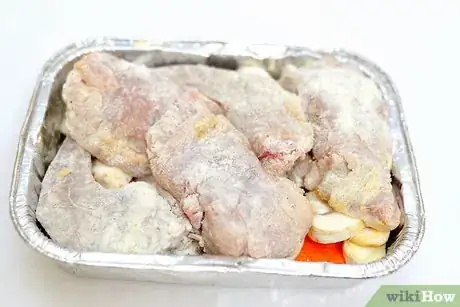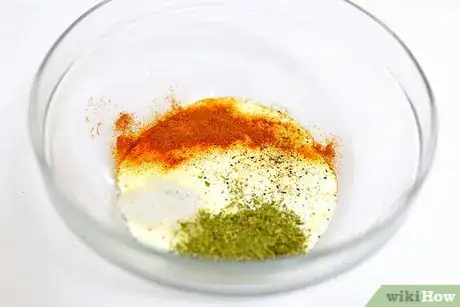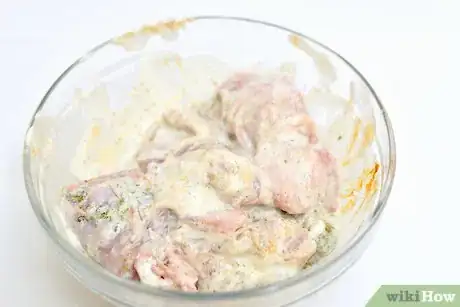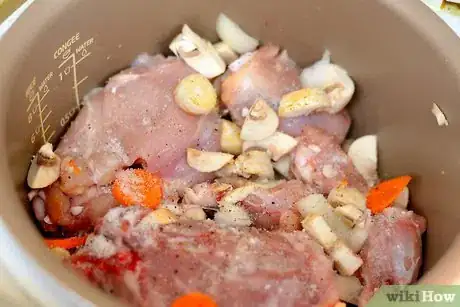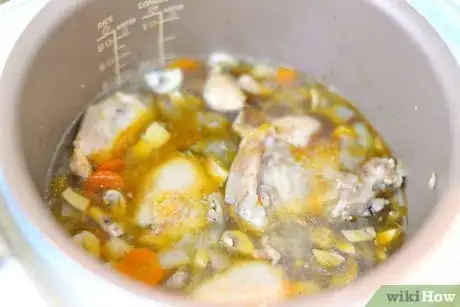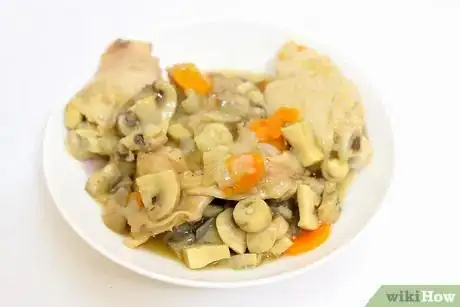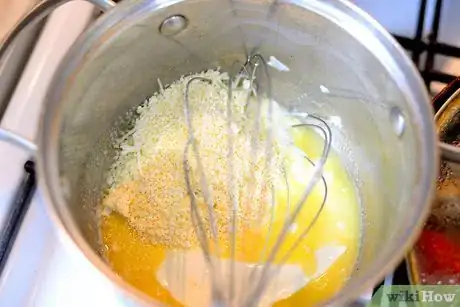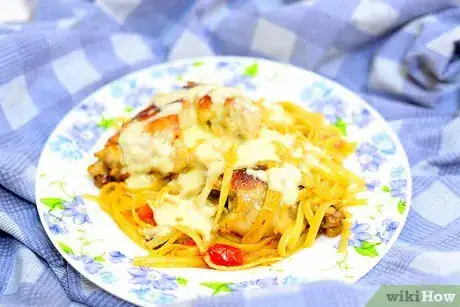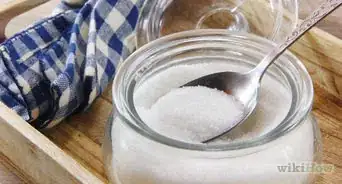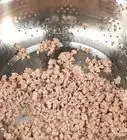wikiHow is a “wiki,” similar to Wikipedia, which means that many of our articles are co-written by multiple authors. To create this article, 11 people, some anonymous, worked to edit and improve it over time.
There are 10 references cited in this article, which can be found at the bottom of the page.
This article has been viewed 252,273 times.
Learn more...
Rabbit meat is leaner than beef, pork, and chicken, and it can also be a good source of protein. There are multiple ways you can cook rabbit, but here are a few good ones to start with if you have never prepared this meat before.
Ingredients
Makes 2 servings
- 1 whole farmed rabbit, cut into pieces
- 4 Tbsp (60 ml) olive oil
- 2 Tbsp (30 ml) Dijon mustard
- Salt and ground black pepper, to taste
- 3 Tbsp (45 ml) unsalted butter, duck fat, or lard
- 1/2 cup (125 ml) rabbit or chicken stock
Makes 6 to 8 servings
- 2 rabbits, cut into pieces
- Salt and ground black pepper
- 1/2 cup (125 ml) all-purpose flour
- 2 Tbsp (30 ml) olive oil
- 2 onions, sliced
- 2 cloves garlic, minced
- 6 carrots, peeled and sliced
- 1 lb (450 g) fresh mushrooms, sliced
- 2 Tbsp (30 ml) fresh parsley, minced
- 1/4 tsp (1.25 ml) thyme
- 1/4 tsp (1.25 ml) oregano, rubbed
- 4 bay leaves
- 2 cups (500 ml) dry white wine
Makes 4 servings
- 2 farmed rabbits or 3 wild rabbits, cut into pieces
- 2 cups (500 ml) buttermilk
- 2 Tbsp (30 ml) Italian seasoning
- 1 Tbsp (15 ml) paprika
- 1 Tbsp (15 ml) garlic powder
- 2 tsp (10 ml) cayenne pepper
- 2 cups (500 ml) flour
- 1 tsp (5 ml) salt
- 2 cups (500 ml) vegetable oil
Makes 6 to 8 servings
- 2 rabbits, cut into pieces
- 1 cup (250 ml) celery, sliced
- 1 cup (250 ml) carrots, peeled and sliced
- 1 onion, chopped
- 8 oz (250 ml) can of water chestnuts, sliced
- 2 cups (500 ml) fresh mushrooms, sliced
- 3 cups (750 ml) chicken broth
- Salt and ground black pepper, to taste
- 2 Tbsp (30 ml) cornstarch
- 1/2 cup (125 ml) sherry
Makes 4 servings
- 1 lb fettuccine noodles
- 1 lb boned rabbit cut into strips or chunks
- 3 Tbsp butter
- 1 medium tomato, chopped
- 1/4 cup of broccoli
- 1/4 cup of butter
- 1 cup heavy cream
- 1 clove of garlic, crushed
- 1 1/2 cups of grated Parmesan cheese
Steps
Roasted Farmed Rabbit
-
1Mix the marinade. Combine the olive oil, Dijon mustard, and a dash of black pepper in a bowl, whisking the ingredients together thoroughly.
- You can mix the marinade in a large resealable plastic bag or inside a dish that is large enough to fit all the rabbit pieces in a single layer.
-
2Marinate the rabbit for at least 1 hour. Place the rabbit pieces into the marinade and toss well to coat. Cover and refrigerate for a minimum of 1 hour, if not longer.
- When roasting an entire rabbit, only use farmed rabbit. If using wild rabbit, only use the saddle or torso of the rabbit. Farmed rabbit has much more fat, so it fares better in dry heat methods like roasting than wild rabbit does.
- Since the saddle of wild rabbit is fatty enough, though, it can still be roasted. Use 2 large saddles or 4 smaller saddles from wild rabbits in place of 2 full farmed rabbits.
- Marinating the rabbit for 2 hours is actually ideal since the marinade will have more time to permeate and flavor the meat.
Advertisement -
3Preheat the oven to 425 degrees Fahrenheit (220 degrees Celsius). Prepare an ovenproof frying pan by adding the butter to it and warming it over medium-high heat.[1]
- Continue heating the butter until it melts.
- Duck fat or lard can also be used instead of unsalted butter.
-
4Brown the rabbit pieces. Add the rabbit to the butter in the frying pan and cook it for 3 to 5 minutes on each side, or until browned on each side.[2]
-
5Cook the rabbit in the oven. Transfer the ovenproof frying pan with the rabbit and remaining butter into the preheated oven. Cook for about 6 to 8 minutes before testing the pieces for doneness.
- When done, the meat should feel firm and there should no longer be any internal redness or blood.
- Drain the pan drippings before returning the pan to the stove.
-
6Add the stock and heat. Pour the stock into the frying pan and heat it over medium until the stock begins to simmer.
- The simmer should be fairly gentle. Do not let the stock reach a rapid, rolling boil.
-
7Let rest before serving. Remove the frying pan from the heat and let it rest in a warm area for 10 minutes. Serve while still warm.
Braised Rabbit
-
1Preheat the oven to 350 degrees Fahrenheit (180 degrees Celsius). Prepare a casserole dish by spraying it with nonstick cooking spray.
- For this method, avoid preparing the dish by lining it with aluminum foil or parchment paper. Cooking spray will have the most limited effect on flavor and will not negatively impact the way that the vegetables cooked alongside the rabbit taste and cook.
-
2Dredge the rabbit pieces with flour. Sprinkle salt and black pepper over the rabbit pieces before tossing them into the flour. Make sure that all sides of the rabbit are coated well.[3]
- You could combine the flour with the salt and pepper beforehand or add the salt and pepper to the rabbit separately. Either method will work.
- Pour the flour into a large resealable plastic bag or into a shallow dish before dredging the rabbit pieces. If you use a bag, you can toss the pieces into the bag, seal it, and shake thoroughly. If using a shallow dish, turn and coat all sides by hand.
-
3Arrange the oil and vegetables in the prepared casserole dish. Place the onion slices, minced garlic, sliced carrots, and sliced mushrooms in your casserole dish. Drizzle with oil and toss well to coat.
- Try to keep the various vegetables as evenly distributed as possible to ensure even cooking.
-
4Place the rabbit pieces on the vegetables. Arrange the floured rabbit pieces on top of the vegetable layer. Keep the rabbit in a single layer so that the pieces cook evenly.
-
5Add the herbs and wine. Sprinkle the parsley, thyme, and oregano over the rabbit pieces and vegetables evenly. Stick the bay leaves into the vegetable medley and pour the wine over the contents of the dish evenly.
- Make sure that the liquid in the dish reaches the level of the rabbit pieces. In order to actually braise the rabbit, the meat itself needs to sit inside the cooking liquid as it cooks.
-
6Bake for 1 hour. Cover the dish and bake it until the rabbit becomes tender.
- Use aluminum foil to cover the dish if you end up using a dish without an oven-proof lid.
-
7Remove bay leaves and serve. Fish the bay leaves out of the casserole dish. Serve the rabbit while still warm, serving the vegetable blend alongside it.[4]
Fried Rabbit
-
1Mix the buttermilk and the spices. Whisk the buttermilk together with the Italian seasoning, paprika, garlic powder, and cayenne pepper in a small dish until well combined.
- If you do not have an Italian seasoning blend, you could substitute 1/2 cup mixed and chopped fresh herbs. Use herbs like oregano, thyme, and parsley.
-
2Marinate the rabbit pieces. Place the rabbit pieces in the spiced buttermilk and turn to coat all sides. Cover and refrigerate 8 hours to overnight.
- A longer marinating time means a stronger flavor and more tender meat.
-
3Pour the oil in a large heavy-bottomed pan and let it heat up. Bring the oil to temperature over medium-high heat. Ideally, the oil should be heated to a temperature around 325 degrees Fahrenheit (160 degrees Celsius).[5]
- Check the temperature of the oil using a candy thermometer. Note that you may need to continually check the temperature of the oil during the cooking process to make sure that it does not get too cool or too hot. Do not let the oil smoke at any point during the cooking process.
- If you do not have a candy thermometer, test the oil by quickly sprinkling flour into it. The flour should sizzle upon contact.
- A large cast iron frying pan is the ideal type of pan to use.
- Keep in mind that once you add the rabbit pieces, the oil should reach roughly the halfway point up along the side of the pieces.
-
4Drain the rabbit. Place the rabbit pieces in a colander and let the buttermilk drain from it naturally for a couple of minutes.
- Do not shake the buttermilk off or try to wipe the excess away. Simply allow the excess to drip off via the assistance of gravity.
-
5Dredge the rabbit in the flour mixture. Mix the flour and salt in a large plastic bag, shaking until well combined. Place a few pieces into the bag and shake well to coat all sides.[6]
-
6Fry for 22 to 30 minutes, turning once. Fry for 12 to 15 minutes at a steady sizzle. Turn using tongs and fry for another 10 to 15 minutes.[7]
- The rabbit should fry at a gentle sizzle. It should not be violent, but it should do more than merely sit in the oil.
- Remove all the pieces separately as they turn crispy and golden brown. The belly flap pieces and forelegs will finish up first. The loin will be next, and the hind legs will be last.
- If you need to fry the rabbit pieces in batches, let them drain in the colander as they wait. Only flour the rabbit pieces immediately before you intend to fry them.
-
7Drain and serve. Transfer the rabbit pieces to layers of clean paper towels or brown paper bags. Let drain for a few minutes before serving, and serve the pieces hot or at room temperature.[8]
Slow-Cooked Rabbit
-
1Place the first nine ingredients in a slow cooker. Layer the rabbit pieces, celery, carrots, onion, water chestnuts, and mushroom inside the slow cooker. Pour the chicken broth over the contents of the slow cooker and sprinkle with salt and pepper as desired.
- If you are not sure about how much salt and pepper to go with, try 1 tsp (5 ml) of salt and 1/2 tsp (2.5 ml) of pepper.
-
2Cook on low for 6 hours. Cover the slow cooker and let the rabbit cook until it becomes tender enough to fall apart when cut into with a fork.[9]
- The cover must stay on throughout the entire 6 hours. If you remove the cover, you will allow some of the heat that has built up inside to escape. This heat is an essential element involved in cooking the contents of the slow cooker, though, so letting any at all escape can affect the cooking time.
-
3Combine the sherry and cornstarch. Vigorously whisk the two ingredients together in a small dish until well combined into a slurry.
-
4Thicken the sauce. Remove the rabbit from the slow cooker and stir the corn starch slurry into the remaining sauce. Cover and cook on high for 10 to 15 minutes, or until the sauce thickens.
- Alternatively, you could pour the sauce into a medium saucepan and add the cornstarch slurry to it that way. Heat the contents of the saucepan on medium-high until they reach a boil. Let boil for 1 to 3 minutes, or until the sauce thickens.
- Keep the cooked rabbit pieces warm as you thicken the sauce.
-
5Mix the rabbit back into the slow cooker. Add the rabbit back to the sauce in the slow cooker and mix gently to coat.
- The purpose behind this step is to coat the rabbit in the final sauce while also reheating it through.
-
6Serve. Transfer the rabbit pieces to individual serving dishes. Ladle the sauce over the rabbit before serving.
Coniglio Fettuccine Alfredo
-
1Prepare noodles according to package instructions.[10]
-
2Season rabbit, if desired, with salt and pepper. Melt 3 Tbsp. butter in a 12 inch (30.5 cm) skillet over medium-high heat and cook rabbit, stirring occasionally, until rabbit is thoroughly cooked. Remove rabbit from pan and set aside.[11]
-
3Add tomatoes and broccoli into the same skillet, reduce to medium heat, and cook, stirring occasionally, until tender. Add cooked rabbit back to skillet and keep warm.
-
4Melt ¼ cup of butter in a medium saucepan over medium-low heat. Add the cream, reduce heat, and simmer for 5 minutes, stirring constantly; then add the garlic and cheese and whisk quickly, heating through.
-
5Add sauce to meat in skillet and serve over hot fettuccine noodles.
-
6Finished.
Community Q&A
-
QuestionIs it legal to eat my neighbor's pet rabbits if they hop into my yard?
 Community AnswerNo, it is not.
Community AnswerNo, it is not. -
QuestionHow do I test wild rabbit meat for disease?
 Community AnswerYour local Agriculture Rep can tell you if there are any ongoing issues with wild rabbits, as can the CDC. That's easier than trying to test somehow on your own.
Community AnswerYour local Agriculture Rep can tell you if there are any ongoing issues with wild rabbits, as can the CDC. That's easier than trying to test somehow on your own.
Warnings
- Rabbit meat can be a source of various diseases, so you should test the meat before consuming it.⧼thumbs_response⧽
Things You'll Need
Roasted Rabbit
- Whisk
- Resealable plastic bag or large dish and plastic wrap
- Ovenproof frying pan with lid
- Tongs
Braised Rabbit
- Casserole dish
- Nonstick cooking spray
- Resealable plastic bag or shallow dish
- Tongs
- Aluminum foil
Fried Rabbit
- Whisk
- Large dish
- Plastic wrap
- Heavy-bottomed frying pan
- Candy thermometer
- Colander
- Large resealable plastic bag
- Tongs
- Paper towels or brown paper bags
Slow-Cooked Rabbit
- Slow cooker
- Small dish
- Whisk
- Tongs
- Ladle
- Medium saucepan (optional)
References
- ↑ https://www.theguardian.com/lifeandstyle/2010/feb/15/how-to-prepare-roast-rabbit
- ↑ https://www.foodandwine.com/recipes/casserole-roasted-rabbit-herbs
- ↑ https://www.allrecipes.com/recipe/136629/braised-rabbit-with-mushroom-sauce/
- ↑ https://www.tasteofhome.com/recipes/braised-rabbit/
- ↑ https://honest-food.net/fried-rabbit-recipe/
- ↑ https://www.foodrepublic.com/recipes/buttermilk-fried-rabbit-recipe/
- ↑ https://honest-food.net/fried-rabbit-recipe/
- ↑ https://www.bonappetit.com/recipe/fried-rabbit
- ↑ https://www.bestrecipes.com.au/recipes/slow-cooker-rabbit-recipe/nxccle8b
About This Article
To cook roasted rabbit, start by marinating the rabbit for 1 hour in a mixture of olive oil, Dijon mustard, and black pepper. Then, heat 3 tablespoons of butter in an ovenproof frying pan, add the rabbit, and brown the pieces for 3 to 5 minutes on each side. Next, transfer the pan to a 425 degree F oven, cook for 6 to 8 minutes, and drain the pan drippings. Afterwards, put the pan back on the stove, add ½ cup of chicken stock, and cook until the stock begins to simmer.. To learn more, including how to cook braised rabbit and fried rabbit, scroll down.
